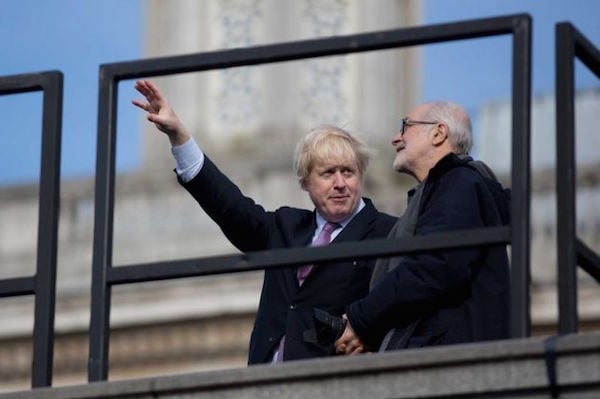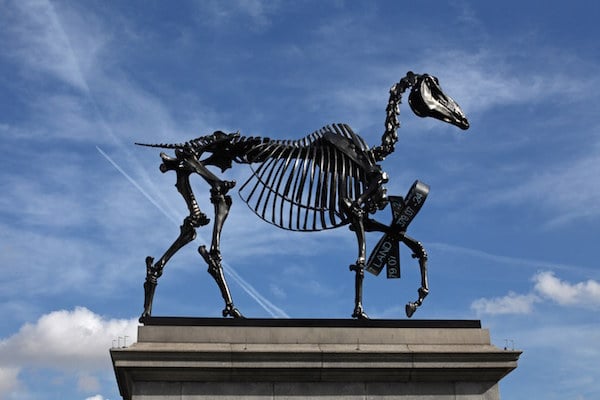Opinion
Hans Haacke Fourth Plinth ‘Gift Horse’: Is This Propaganda We Can All Agree With?
London's newest public sculpture is a monument to received wisdom.

Photo via: Newstimes
London's newest public sculpture is a monument to received wisdom.

JJ Charlesworth

What’s this? A lethal artistic blow against capitalism, right here in the beating heart of the British capital and, well, British capitalism itself? Is it time for revolution? Quick! Someone get Russell Brand, a PA system and some massed crowds! It’s all going to kick off!
Or maybe it isn’t. Veteran political conceptualist Hans Haacke’s Gift Horse, unveiled at the beginning of the month, is the latest in the series of sculptures commissioned for the Fourth Plinth on London’s Trafalgar Square, the site of many a massed political demonstration in British history. A bronze cast enlargement of the skeleton of a horse, Gift Horse is a mocking echo of the equestrian statue of king George IV, who sits grandly on his horse on the opposite side of the square. But on Gift Horse’s raised foreleg is a sort of bow, whose surface is an LED “tickertape” readout that streams stock prices live from the London Stock Exchange.
So it’s a political statement, if you like, but while commentators have fallen over themselves to make out that Haacke’s sculpture is “controversial” (the regularly mistaken Waldemar Januszczak declaring that Haacke’s sculpture was “like letting Trotsky loose on Buckingham Palace”), the interesting thing is that Haacke’s Gift Horse is exactly the opposite—it’s the visual articulation of what most of us think all the time anyway; that we may be mesmerised by the promise of capitalist economics and the magic of financial capital, but hey! All that stuff is just a dangerous illusion. The old warning against “looking a gift horse in the mouth”—meaning that a horse’s value can’t be assessed merely by checking its teeth—might be a bit of homey everyday morality, but as political statements go, it isn’t exactly the communist manifesto.
Far from a provocative criticism of capitalist excess
But in a way, Gift Horse is exactly that kind of moral truism which tends to substitutes for critical or political thinking today: that the mechanism of the free market produces negative consequences is one of those vague assertions that everyone more or less agrees to, even if you’re politically on the right. After all, while many on the left in the UK have railed against the cuts in welfare imposed by our conservative-led coalition, it’s the same coalition that has been busy re-regulating the financial sector, imposing new rules of responsibility on lenders and breaking up and reorganising the banks, in order to control the perceived risks of runaway capitalism—even supposedly free-market people aren’t really very pro-free market these days.
So, far from being a provocative criticism of capitalist excess that might split the public, Gift Horse is so non-controversial that even London’s Conservative mayor, Boris Johnson, could give it his usual blustering, mock-moronic approval, claiming, inevitably, that it would “get people talking”. The Mayor’s warm welcome seems to have thrown Haacke, who has said that his proposal had seemed a “good joke” at the time, but that he hadn’t expected it to win, declaring that in his hometown of New York “there is no way that something that plays with Wall Street in this fashion would ever be approved under the auspices of the mayor.” (see Hans Haacke’s Fourth Plinth Horse Panders To Those It’s Meant to be Critiquing).

Haans Haacke’s Gift Horse (2015)
Photo: Fourth Plinth
What’s deathly about this—for art at least—is its sheer, crass, patronising didacticism
But Haacke might have been less surprised if he had paid attention to the previous commissions that have occupied the Fourth Plinth, since so many of them have been attempts to address, in the most dumb, didactic way possible, the kinds of issues that on the surface seem a bit edgy, but are in reality part of the consensus of liberal and left-leaning values and attitudes that plays well with the constituency of a big, multicultural metropolis like London. So previous sculptures have addressed issues of disability rights (in Marc Quinn’s Alison Lapper Pregnant, 2005-07), colonialism and imperialism (in Yinka Shonibare MBE’s Nelson’s Ship in a Bottle, 2010-12) and war and militarism (in Elmgreen and Dragset’s Powerless Structures, Fig. 101, 2012-13), while Trafalgar Square was the site of an environmentalist consciousness-raising sculpture Ghost Forest by Angela Palmer in 2009.
Maybe we all think that war, colonialism and imperialism are bad things. Maybe we agree that disabled people should have equal rights and that we should stop cutting down the rainforest and be nicer to the environment, and that capitalism is a bit out of control and should be reigned in from its worst excesses (without, of course getting rid of it completely, right?). Of course we do, because if we didn’t we’d be arseholes, wouldn’t we? But playing out this roll-call of politically correct preoccupations shows up that there’s nothing very controversial or disruptive about Haacke’s sculpture or any of its predecessors. And what’s deathly about this—for art at least—is its sheer, crass, patronising didacticism: if we agree with the “message,” then everything is fine, and if we don’t, then the sculpture is there to gently re-educate us in the “right” way of thinking about a particular issue, as if we were too dumb to have our own opinions about such questions.
Maybe it’s touchy-feely and a bit liberal-left, but it’s still propaganda
This isn’t sculpture, it’s propaganda. Maybe it’s touchy-feely and a bit liberal-left, but it’s still propaganda, because the intention is simplistic and pedagogical. Public art projects like London’s Fourth Plinth serve to “get us talking,” but only about those issues that those in power want us to talk about. And artists, even “critical” artists like Haacke who have a track record of making work that upsets and causes controversy (sadly too long ago now), end up playing into the hands of canny city politicians who realise that a bit of toothlessly “edgy” art makes their city a more attractive place to live for non-domiciled oligarchs and hedge-fund managers.
But in one of those odd tangles of political timing, this month served to remind us of the other side of Boris Johnson’s squeaky-clean, cosmopolitan, liberal city. On Saturday, David Cameron was unveiling a sculpture of the hero of non-violent political action, Mahatma Gandhi, on Parliament Square, a stone’s throw from Trafalgar Square (see London To Commemorate Gandhi in Parliament Square). The following Tuesday, answering questions to the Home Affairs Committee, home secretary Theresa Mills explained that she hadn’t yet given approval for the deployment of three anti-riot water cannons bought by—can you guess who?—London mayor Boris Johnson. “Because,” May explained, “they require a great deal of testing and re-testing.”
Maybe the next commission for the Fourth Plinth (after David Shrigley’s daft giant thumbs up, Really Good, next year) could be one of Boris’s non-functioning water cannons, continually trained on passers-by. Now, would that “get us talking”?